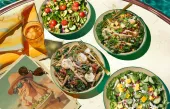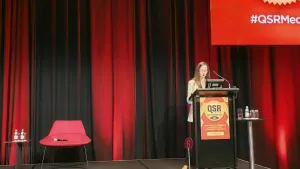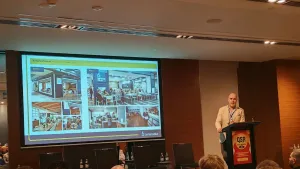
How Bakers Delight, Soul Origin and Huxtaburger are marketing themselves to the smarter consumer
QSR Media talks to the chains’ marketing executives to discuss the latest trends and challenges.
Whilst convenience remains king, the smartphone age has provided consumers numerous ways of how it can look like - an evolving trend marketing executives from select restaurant brands say the industry should continue to take a closer look at.
Bakers Delight, which made headlines with its most recent Pink Bun campaign, says consumers are already time poor and “want everything now”, especially the millennial age group.
“We seem to have lost the art of patience and created a “I want it now’ generation, so grab ‘n’ go, quick & easy meal solutions and getting products into people’s hands for fast consumption will mean the demand for services like Uber Eats and Deliveroo will continue to increase,” Bakers Delight advertising and retail marketing manager Jodi Murray-Freedman told QSR Media.
(Also read: Ahead of turning 40, Bakers Delight wants to stake a claim in the ordering game)
Soul Origin, which continues to roll out its Hearty AF soup range, observed an increase in consumers wanting product customisation and information.
“Today, a customer may be “being good” and want a light green salad and to “hold the dressing” whereas tomorrow, they will want something richer, indulgent and filling. They also expect to have information at their fingertips like exactly what’s in the salad, what’s in the dressing, where the ingredients are sourced, and what the packaging is made of,” Soul Origin national manager for brand and marketing Avril-Summer Cusack explained.
Huxtaburger head of marketing Abby Islas agrees, noting the importance of recognising the emergence of “smarter” consumers, a notable factor in the shift of how Aussies are eating. The Melbourne-based brand recently launched its Huxta Chicken range.
“It is really important to note that we have a much smarter consumer on our hands. Caring is the new cool; whether that’s in the form of self-love or advocating societal issues, consumers are being more selective about which brands they choose to align themselves with and support by purchasing their products,” she said.
“The most obvious example happening right now is the focus on the health of the environment. The issue of single use plastic is a big one for hospitality industry. For many of us, this means relooking at the packaging we are using and trying to find or create environmentally friendly solutions. It is really important that businesses are mindful of this change in behaviour and are adapting, as years from now consumers may not be as forgiving.”
Local marketing, unique brand voice
Asked on how their brands differentiate their respective marketing strategies, the two larger chains stressed their focus on franchisee support and product development as related components.
Bakers Delight, now with over 600 stores locally, says their tone of voice in their communications also helps them stand out.
“Every one of our franchisees is a small business owner and a vital member of their local community, which we try to remind customers about at every opportunity. From a product development perspective, we always try to create products that are unique to Bakers Delight such as our famous Savoury Bites or our iconic Cheesymite Scroll,” Murray-Freedman said. “We are humble, a little cheeky and colloquial.”
Soul Origin, now with 108 stores, says local marketing is a “core focus” to ensure efficiency and effectiveness.
“It is incredibly important that (our) marketing gains immediate brand awareness with local residents and workers within areas of new sites from day one. We get a terrific response in foot traffic with our “Free Coffee Day” offer at new store openings,” Cusack explained. “We also work very closely on our Marketing 101 program with incoming franchise partners and we support them in working with their centre management team to maximise any additional consumer communication platforms.”
Lifestyle brand status eyed
Whilst taste would remain a key brand pillar for them, Huxtaburger says the long-term goal, marketing-wise, is to be a lifestyle brand.
“Other brands tend to keep the focus on their food offering by talking about the quality of their products, sharing farm to table stories and the idea of' “health”. Whilst taste will always be a key brand pillar at Huxtaburger, we shine the light on our lifestyle brand pillar, with the long-term goal of being recognised as lifestyle brand, as well as a food brand,” Islas explained.
She adds that they have explored this particular angle more through the creation of a hang-over breakfast menu on delivery, allowing customers to purchase phone chargers, toothbrush and toothpaste kits; pink glitter shaker fries to celebrate the LGBTQI+ community and supporting Wear It Purple Day by turning our signature burger buns purple for a day and donating $1 from every Huxtaburger sold to Minus18.
“Most of our key brand campaigns focus on communicating the personality, attitude and values of our brand. In a heavily competitive burger market, we want to create brand-love with our consumers. We want to be relatable on a very real level and give them a reason to choose us over our competitors,” Islas added.
Maintaining quality, using information, budgets
Asked about notable challenges, the three marketing executives discussed a selection of variables - ranging from brand perception to budgets.
“We have trained consumers to only buy on promotion or when discounted, so making sure your brand is perceived as a high quality offering and being worth the extra spend is always a challenge, especially for a business like ours where we bake fresh on site,” Murray-Freedman said.
“More than ever before, we have access to an overload of information, some of which can strategically guide a business to success. It’s about knowing what information the business needs and when, it’s relevance, assessing its credibility and dependability, then what to do with it and how to go about implementing any necessary action,” Cusack said.
“One of the biggest challenges is always execution of marketing campaigns at store level. When you have team members who are still in school and are only coming in for a few hours each week, you have a very small window to educate them on new campaigns, teach them any new procedures and, most importantly, get them excited about what’s happening,” Islas explained.
“Another challenge is budgets. In the QSR space, our profit margins aren’t as high as other industries and with the introduction of delivery, which is still a hot topic, it is having a significant impact on the budget available versus the volumes we are doing.”



























